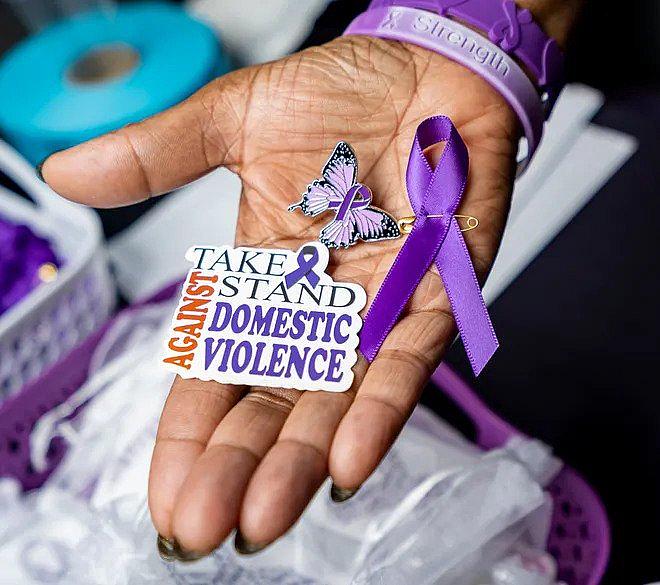How we examined local homicides related to domestic, family and intimate partner violence
The story was originally published in Milwaukee Journal Sentinel with support from our 2023 Domestic Violence Impact Fund.

Ribbons, stickers and pins to raise awareness of domestic violence are seen at the Love Without Violence conference hosted by the Milwaukee Office of Community Wellness and Safety on Friday, October 20, 2023.
Jovanny Hernandez / Milwaukee Journal Sentinel
The Milwaukee Journal Sentinel undertook an analysis of homicides related to domestic, family and intimate partner violence in Milwaukee County from 2016 to 2022.
Police agencies, advocacy organizations and others track domestic violence homicides and deaths differently.
Law enforcement, for example, typically is limited to the definition of domestic violence in state law. In Wisconsin, domestic violence means people who are or have been married, who have a child together or who live or have lived together. It does not include people who were current or former dating partners.
The Journal Sentinel compiled an initial list of homicides related to domestic and family violence using Milwaukee Police Department data, annual statewide homicide reports from End Domestic Abuse Wisconsin and data compiled by The HOPE Domestic Violence Homicide Help website, a project of Rainbow House, a domestic violence shelter in northeast Wisconsin.
The Journal Sentinel then requested and reviewed thousands of pages of publicly available documents about those cases from circuit court, police departments and the Milwaukee County medical examiner’s office. The review also included media reports.
In particular, the Journal Sentinel relied on court transcripts of sentencing hearings, medical examiner reports and obituaries to identify if victims had children and if a child had been present during the homicide.
This is a conservative estimate, as are the figures for the number of people who lost a parent and the instances of homicides where a child was present. There are almost certainly more, but the news organization was limited to publicly available information and included only what could be confirmed through the records.
The Journal Sentinel then classified the types of homicide using descriptive terms:
- Intimate partner violence encompassed homicides involving a victim and suspect in a romantic or sexual relationship, including current or past dating partners.
- Domestic violence encompassed homicides involving current or former spouses and current or former couples who shared children.
- Violence-child referred to children killed in the same incident as a domestic violence or intimate partner killing or assault.
- Family violence included people who killed a relative, usually a parent or sibling.
- Child abuse and neglect homicides were categorized separately.
- Rivalry referred to a homicide between someone's current and former romantic partners.
- Retaliation in this context referred to fatal encounters between relatives or friends who became aware of domestic violence allegations and confronted an alleged abuser.
- Co-habitant applied to victims and suspects who lived together but were not dating or related.
- Bystander referred to individuals killed who had nothing to do with the underlying domestic abuse allegations.
The Journal Sentinel tracked offender deaths, most of which were suicides taking place immediately after a homicide, but did not include those in the total cases of homicides.
Findings align with domestic violence research elsewhere
The Journal Sentinel asked local and national experts to review its findings in advance of publication. The experts said the findings tracked with previous research in other parts of the country and with local trends.
"It does track," said Jacquelyn Campbell, a professor at the Johns Hopkins School of Nursing, who created a danger assessment to help identify domestic violence cases likely to end in homicide.
The Sojourner Family Peace Center in Milwaukee has compiled a total of 251 domestic-violence-related deaths in the county over the same time period examined by the Journal Sentinel.
Sojourner’s director of outcomes and evaluations, Erin Schubert, said the center's data includes offender suicides in its total. She also noted the advocacy organization has access to confidential data and knows if a victim had previously sought services at Sojourner. Those two factors likely contributed to the difference in the total, she said.
A forthcoming report from Sojourner also found 32% of the cases referred to the county's Domestic Violence High Risk Team had been witnessed by children. That is similar to the Journal Sentinel's finding that children were present at 43% of the homicides in its dataset.
The Milwaukee Police Department also reviewed the Journal Sentinel's findings and noted the trends were similar to what the department tracked. The department also shared that one in three victims of aggravated assault — which can include nonfatal shootings, stabbings and serious beatings — were injured in acts of domestic violence.


